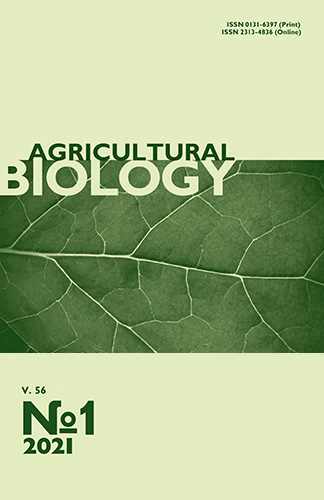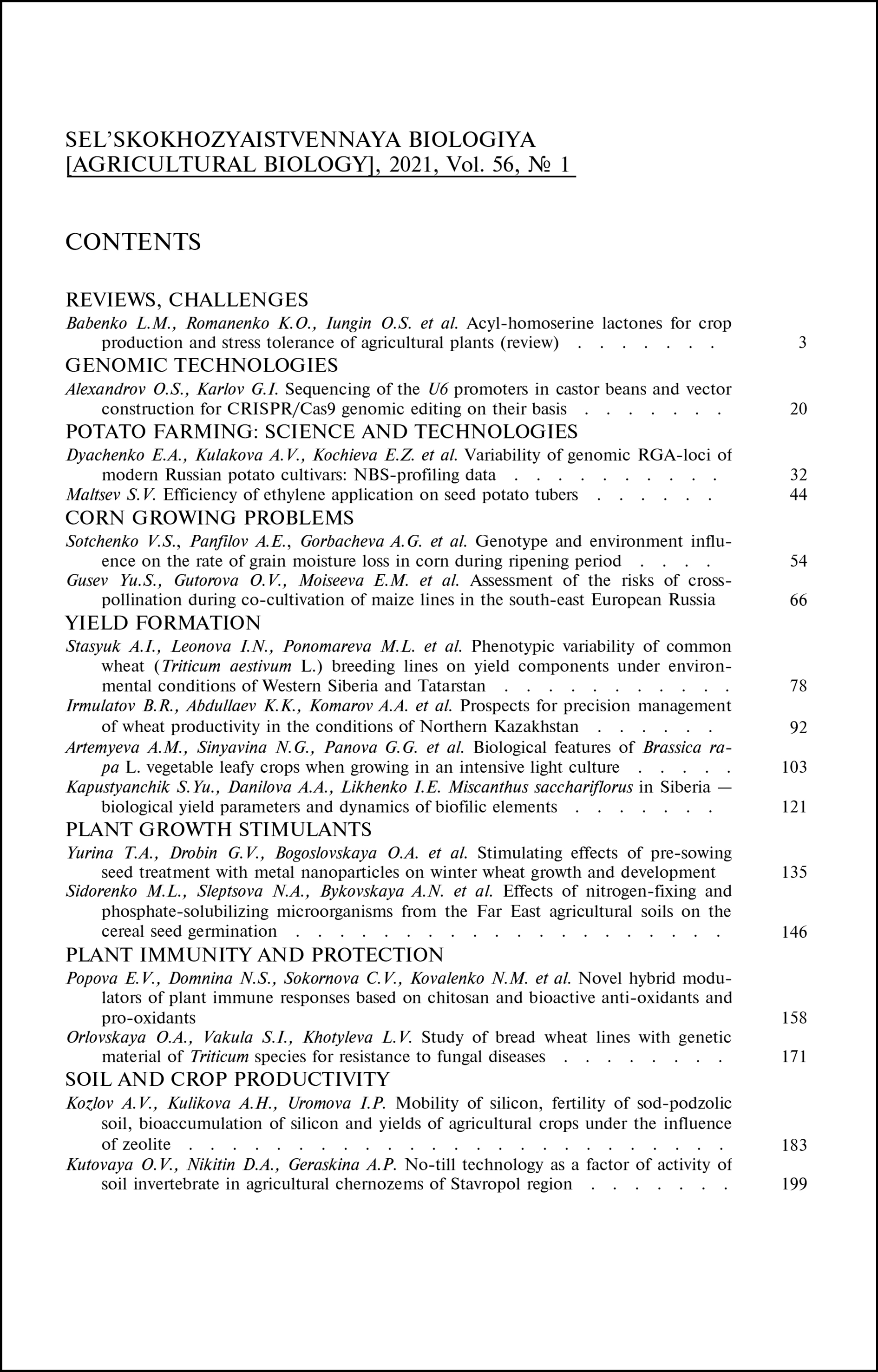doi: 10.15389/agrobiology.2021.1.121eng
UDC: 633.282:631.559:631.452:631.417.1
Acknowledgements:
The authors thank O.M. Potseluev, the Head of the Laboratory of Biotechnology SibNIIRS — Branch of the ICG SB RAS and S.A. Kolbin, the Senior Researcher of the Soil Fertility Laboratory, the Siberian Research Institute of Agriculture and Chemicalization of the Siberian Federal Scientific Center of Agro-Bio Technologies RAS for assistance in the field trials and analysis of biomaterials.
Supported financially by the budgetary project of the ICG SB RAS No. 0324-2019-0039-C-01 and the state assignment of the SFSCA RAS (project No. 0778-2018-0002)
Miscanthus sacchariflorus IN SIBERIA — BIOLOGICAL YIELD PARAMETERS AND DYNAMICS OF BIOFILIC ELEMENTS
S.Yu. Kapustyanchik1 ✉ , A.A. Danilova2, I.E. Likhenko1
1Siberian Research Institute of Plant Cultivation and Breeding — Branch of Institute of Cytology and Genetics, SB RAS, 21, ul. C-100, Krasnoobsk, Novosibirsk Province, Russia 630501, e-mail kapustyanchik@bionet.nsc.ru (✉ corresponding author), lihenko@mail.ru;
2Siberian Federal Scientific Center of Agro-Bio Technologies RAS, ul. Tsentralnaya, Krasnoobsk, Novosibirsk Province, 633501 Russia, e-mail Danilova7alb@yandex.ru
ORCID:
Kapustyanchik S.Yu. orcid.org/0000-0002-2954-0620
Likhenko I.E. orcid.org/0000-0002-0305-1036
Danilova A.A. orcid.org/0000-0002-2212-3074
Received June 26, 2020
Throughout the world, bioenergy crops are grown to replace fossil resources and reduce greenhouse gas emission. Miscanthus is one of the bioenergetic plants that is widely cultivated in countries with optimal hydrothermal conditions. There is little research on the specifics of Miscanthus spp. cultivation in the continental climate. The aim of the study was a preliminary assessment of the possibility of Miscanthus cultivation in Siberia. The production process of Miscanthus sacchariflorus cv. Soranovsky (The State Register of Breeding Achievements, patent No. 6931 dated 06/06/2013) was assessed under conditions of the Central Forest-Steppe of Novosibirsk Ob (Novosibirsk Province, 54°53'13,5"N, 82°59'36,7"E, agro-gray soil, the experimental base of the Siberian Research Institute of Plant Cultivation and Breeding). During the formation of Miscanthus long-term stands (1-4 years), the aboveground biomass averaged 13 t/ha, the belowground biomass 17 t/ha. These figures are close to the average for this species in the world. The total N, P and K removal with biomass of stems and leaves was 51, 6, and 49 kg/ha, and with stems it was only 23, 3, and 26 kg/ha, respectively. Accumulation of N, P and K in the belowground biomass was 130, 10, and 126 kg/ha, respectively. Therefore, our experiment did not show any depletion of biophilic elements in soil during a four-year growth of miscanthus. Rough estimates have shown the presence of objective prerequisites for the atmospheric carbon sequestration in the fractions of the soil organic matter. During the first year of Miscanthus vegetation, at least 300 kg/ha of carbon accumulated in the mobile fractions of the soil organic matter; an increase in the C/N ratio in the belowground biomass of Miscanthus up to 74 vs. 20 in the initial soil was accompanied by a significant decrease in the mineralization rate of newly incoming plant residues. The parameters of the production process of Miscanthus sacchariflorus cv. Soranovsky on agro-gray soil in the Central Forest-Steppe of Novosibirsk Ob region correspond to the growth characteristics of M. sacchariflorus cultivated in other regions of the world on different soil types. We conclude that cultivation of M. sacchariflorus in Siberia is ecologically and commercially reasonable.
Keywords: bioenergy crops, Miscanthus sacchariflorus, cv.Soranovsky, aboveground biomass, belowground biomass, soil, nutrient removal, carbon sequestration.
REFERENCES
- Lewandowski I., Clifton-Brown J., Trindade L.M., van der Linden G.C., Schwarz K.-U., Müller-Sämann K., Anisimov A., Chen C.-L., Dolstra O., Donnison I.S., Farrar K., Fonteyne S., Harding G., Hastings A., Huxley L.M., Iqbal Y., Khokhlov N., Kiesel A., Lootens P., Meyer H., Mos M., Muylle H., Nunn C., Özgüven M., Roldán-Ruiz I., Schüle H., Tarakanov I., van der Weijde T., Wagner M., Xi Q., Kalinina O. Progress on optimizing Miscanthus biomass production for the European bioeconomy: results of the EU FP7 project OPTIMISC. Frontiers in Plant Science, 2016, 7(1620): 1-23 CrossRef
- Heaton E.A., Flavell R.B., Mascia P.N., Thomas S.R., Dohleman R.G., Long S.P. Herbaceous energy crop development: recent progress and future prospects. Current Opinion in Biotechnology, 2008, 19(3): 202-209 CrossRef
- Anisimov A.A., Khokhlov N.F., Tarakanov I.G. Novye i netraditsionnye rasteniya i perspektivy ikh ispol'zovaniya,2016, 12: 3-5 (in Russ.).
- Otkrytyi onlain atlas-opredelitel' rastenii i lishainikov Rossii i sopredel'nykh stran. Available: http://www.plantarium.ru/page/view/item/41884.html [Open online atlas of plants and lichens in Russia and neighboring countries]. No date (in Russ.).
- Clifton‐Brown J.C., Lewandowski I. Overwintering problems of newly established Miscanthus plantations can be overcome by identifying genotypes with improved rhizome cold tolerance. New Phytologist, 2000, 148(2): 287-294 CrossRef
- Pude R., Franken H. Reynoutria bohemica — eine Alternative zu Miscanthus ½ giganteus? Die Bodenkultur, 2001, 52(1): 19-27.
- Dong H., Green S.V., Nishiwaki A., Yamada T., Stewart J.R., Deuter M., Sacks E.J. Winter hardiness of Miscanthus (I): Overwintering ability and yield of new Miscanthus ½ giganteus genotypes in Illinois and Arkansas. Global Change Biology — Bioenergy, 2018, 11(5): 691-705 CrossRef
- Shumnyi V.K., Veprev S.G., Nechiporenko N.N., Goryachkovskaya T.N., Slyn'ko N.M., Kolchanov N.A., Pel'tek S.E. Vavilovskii zhurnal genetiki i selektsii, 2010, 14(1): 122-126 (in Russ.).
- Slyn'ko N.M., Goryachkovskaya T.N., Shekhovtsov S.V., Bannikova S.V., Burmakina N.V., Starostin K.V., Rozanov A.S., Nechiporenko N.N., Veprev S.G., Shumnyi V.K., Kolchanov N.A., Pel'tek S.E. Vavilovskii zhurnal genetiki i selektsii, 2013, 17(4-1): 765-771 (in Russ.).
- Dorogina O.V., Vasil'eva O.Yu., Nuzhdina N.S., Buglova L.V., Gismatulina Yu.A., Zhmud' E.V., Zueva G.A., Komina O.V., Tsybchenko E.A. Vavilovskii zhurnal genetiki i selektsii, 2018, 22(5): 553-559 CrossRef (in Russ.).
- Nunn C., Hastings A.F.S.J., Kalinina O., Özgüven M., Schüle H., Tarakanov I.G., Van Der Weijde T., Anisimov A.A., Iqbal Y., Kiesel A., Khokhlov N.F., McCalmont J.P., Meyer H., Mos M., Schwarz K.U., Trindade L.M., Lewandowski I., Clifton-Brown J.C. Environmental influences on the growing season duration and ripening of diverse Miscanthus germplasm grown in six countries. Frontiers in Rlant Science, 2017, 8: 1-14 CrossRef
- Dohleman F.G., Heaton E.A., Arundale R.A., Long S.P. Seasonal dynamics of above‐ and below‐ground biomass and nitrogen partitioning in Miscanthus ½ giganteus and Panicum virgatum across three growing seasons. Global Change Biology — Bioenergy, 2012, 4(5): 534-544 CrossRef
- Masters M.D., Black C.K., Kantola I.B., Woli K.P., Voigt T., David M.V., DeLucia E.N. Soil nutrient removal by four potential bioenergy crops: Zea mays, Panicum virgatum, Miscanthus × giganteus, and prairie. Agriculture, Ecosystems and Environment, 2016, 216: 51-60 CrossRef
- Oliveira J.A., West C.P., Afif E., Palencia P. Comparison of Miscanthus and Switchgrass cultivars for biomass yield, soil nutrients, and nutrient removal in Northwest Spain. Agronomy Journal, 2017, 109(1): 122-130 CrossRef
- Poeplau C., Don A. Soil C changes under Miscanthus driven by C4 accumulation and C3 decompostion — toward a default sequestration function. Global Change Biology — Bioenergy, 2014, 6: 327-338 CrossRef
- Dufoss K. Effects of a 20-year old Miscanthus ½ giganteus stand and its removal on soil characteristics and greenhouse gas emissions. Biomass and Bioenergy, 2014, 69: 198-210 CrossRef
- Robertson A.D., Whitaker J., Morrison R., Davies C.A., Smith P., McNamara N.P. A Miscanthus plantation can be carbon neutral without increasing soil carbon stocks. Global Change Biology — Bioenergy, 2017, 9(3): 645-661 CrossRef
- Shepherd A., Littleton E., Clifton‐Brown J., Martin M., Hastings A. Projections of global and UK bioenergy potential from Miscanthus ½ giganteus — feedstock yield, carbon cycling and electricity generation in the 21st century. Global Change Biology — Bioenergy, 2020,12(4):287-305 CrossRef
- Ye S., Hall S.J. Mechanisms underlying limited soil carbon gains in perennial and cover-cropped bioenergy systems revealed by stable isotopes. Global Change Biology — Bioenergy, 2020, 12(4): 101-117 CrossRef
- Peterburgskii A.V. Praktikum po agronomicheskoi khimii [Workshop on agrochemistry]. Moscow, 1968 (in Russ.).
- Agrokhimicheskie metody issledovaniya pochv /Pod redaktsiei A.V. Sokolova [Agrochemical methods of soil srudy]. Moscow, 1975 (in Russ.).
- Sharkov I.N. Pochvovedenie, 1984, 7: 136-143 (in Russ.).
- Semenov V.M., Kogut B.M. Pochvennoe organicheskoe veshchestvo [Soil organic matter]. Moscow, 2015 (in Russ.).
- Metodicheskie ukazaniya po provedeniyu kompleksnogo monitoringa plodorodiya zemel' sel'skokhozyaistvennogo naznacheniya [Guidelines for comprehensive monitoring of agricultural land fertility]. Moscow, 2003 (in Russ.).
- Brosse N., Dufour A., Meng X., Sun Q., Ragauskas A. Miscanthus: a fast-growing crop for biofuels and chemicals production. Biofuels, Bioproducts and Biorefining, 2012, 6(5): 580-598 CrossRef
- Lewandowski I., Clifton-Brown J.C., Andersson B., Basch G., Christian D.G., Jorgensen U., Jones M., Riche A., Schwarz K., Tayebi K., Teixeira F. Environment and harvest time affects the combustion qualities of Miscanthus genotypes. Agronomy Journal, 2003, 95: 1274-1280 CrossRef
- Besnard A., Ferchaud F., Levrault F., Marsac S., Nguyen E., Savouré M.L. Lignoguide, savoir choisir une culture de biomasse. Bioénergie International, 2013, 26: 6-11.
- Besnard A., Ferchaud F., Levrault F., Nguyen E., Marsac S., Savouré M.L. Le Lignoguide: une aide aux choix des cultures biomasse. Innovations Agronomiques, 2014, 34: 35-50.
- Maughan M. Miscanthus × giganteus productivity: the effects of management in different environments. Global Change Biology — Bioenergy, 2012, 4: 253-265 CrossRef
- Tubeilen F., Rennie T.J., Goss M.J. A review on biomass production from C4 grasses: yield and quality for end-use. Current Opinion in Plant Biology, 2016, 31: 172-180 CrossRef
- Zavarzin G.A. Lektsii po prirodovedcheskoi mikrobiologii [Lectures on natural history of microbiology]. Moscow, 2004 (in Russ.).












